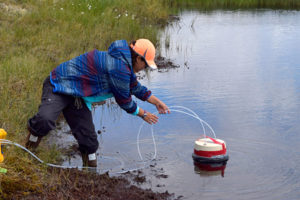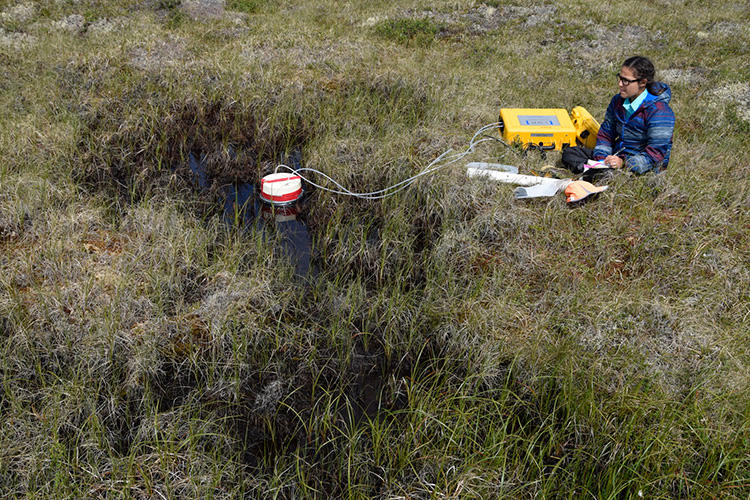The 2017 Polaris Project team spent two weeks studying climate change impact on the tundra of Alaska’s Yukon-Kusksokwim Delta. The team – including students and scientist faculty – returned to the Woods Hole Research Center on July 15 to process the samples they had taken in the field.
By Darcy L. Peter
 When I got accepted to participate in the Polaris Project expedition in February of 2017, I was ecstatic. This was my first big break post-graduation in a research discourse that truly thrilled me.
When I got accepted to participate in the Polaris Project expedition in February of 2017, I was ecstatic. This was my first big break post-graduation in a research discourse that truly thrilled me.
I recently conducted MCF-7 breast cancer research as my senior thesis at Fort Lewis College, where my partner and I were asked to speak about our results at two conferences. This opportunity truly fueled my resolve to remain involved and inspired with conducting scientific research. One can only imagine my enthusiasm when I received that email from Dr. Max Holmes.
What particularly stood out to me regarding the Polaris Project was that they strongly supported the young researchers to develop their own research question and hypotheses based on previously published research, and to choose a topic that best fit our personal area of scientific interest. Being an Environmental and Organismal Biology major at Fort Lewis, I’d already had experience with plant/forest field work in southwest Colorado and as mentioned, I was very involved with cellular and molecular research during my last year of college. After reading a few papers and reflecting on previous research, I decided to focus on carbon gas emissions in various bodies of water and how they differed and/or interacted between burned and unburned sites. Soon after arriving at our field camp in the Yukon-Kuskokwim Delta, our group took a beautiful but exhausting walk around the tundra. I found that physically seeing these bodies of water and their proximity to one another peaked my interest drastically, given that research showed that their emissions were extremely different.
After a meeting with the PIs and other young researchers focusing on each person’s respective area of interest, I found myself partnered up with St. Olaf College graduate Emily Bristol, B.S. who was interested in water chemistry and Carbon formations along a watershed. The next day, PI John Schade, Emily and I were out on the tundra collecting water chemistry kits with pre-made water kits and gathering carbon gas emissions with the “ultra-portable” (41 lbs) gas analyzer, the Los Gatos Research, or as we call it, the LGR. For the next two weeks in the field, Emily and I had found our groove, being fully capable of both completing a water chemistry kit and gathering all C flux data necessary in just 30 minutes. By the end of the two weeks of intense field work, Dr. Paul Mann, the owner of the LGR even named it “Larae,” my middle name. The LGR, Emily, and I have been on many adventures together.
While the research Em and I were conducting was very meaningful and intriguing, there were a few minor frustrations regarding sharing equipment. There were also gaps in our sample sites that needed to be filled – with time working against us. Nonetheless, there was one tremendously useful helicopter day where Stan the Helicopter Man was able to escort Emily and I to our farther away sites that required some of our heavier equipment. In that one day, I collected all of the sediments needed to run an anaerobic incubation, which left me dripping wet getting in and out of the helicopter. Stan graciously offered a personal handkerchief that made me slightly less soaked. I’m very satisfied with everything my research partner/good friend and I completed in the two-week field expedition. Being at the Woods Hole Research Center working with respected senior environmental biogeochemists for the past week and a half has also been a dream come true, spending most of my time analyzing the flux data collected from Larae and setting up my anaerobic incubations. There’s been a lot of quality personal time spent with fellow young researchers and PIs that I certainly cherish deeply.
One aspect of the two-week field work that predominantly caught my eye was that everyone was doing what they’d originally found interesting, with the help of PIs. The PIs (John Schade, Sue Natali, Paul Mann, Max Holmes) helped fuel and feed into our ideas, and really brought them to life. The morale of camp between the young researchers was astounding… I’ve built relationships here that I wouldn’t trade for the world. Being dirty, sweaty, tired and vulnerable with one another also really helped strengthen our relationships. I feel that my being part of this program really confirmed my choice to concentrate on conducting climate change research, and get Arctic communities aware and involved with our changing and vulnerable world.
Darcy Peter graduated this year from Fort Lewis College in Durango, Colorado, with a B.S. in Environmental and Organismic Biology.




